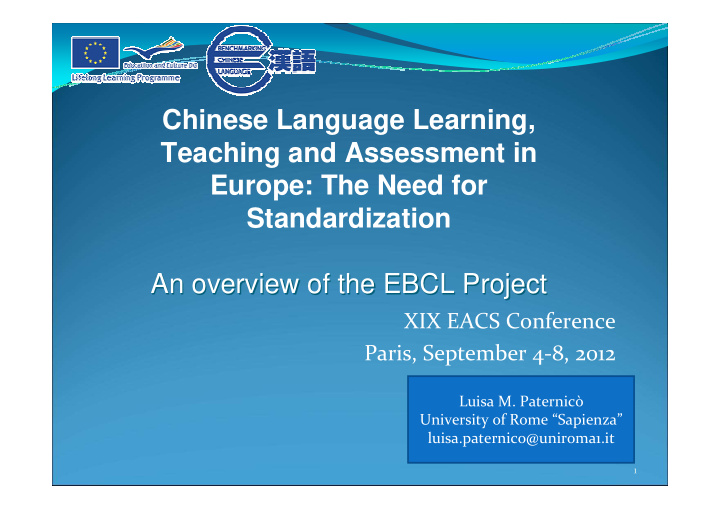



Chinese Language Learning, Teaching and Assessment in Europe: The Need for Standardization An overview of the EBCL Project An overview of the EBCL Project XIX EACS Conference Paris, September 4-8, 2012 Luisa M. Paternicò University of Rome “Sapienza” luisa.paternico@uniroma1.it 1
What’s EBCL The European Benchmarking Chinese Language (EBCL) project aims at creating a reference framework for Chinese Language learning, teaching and assessment in Europe based upon the Common European Framework of Reference for languages (CEFR). 2
EBCL project team: Under the guidance of the Advisory Board Project partners Associated schools � Freie University Berlin, GE � Geschwister Scholl Gesamtschule, GE � University of Rennes II, FR � Collège-Lycée Emile Zola de � “Sapienza” University of Rennes, FR Rome, IT � Convitto Nazionale "Vittorio � School of Oriental and Emanuele II“di Roma , IT African Studies, University of London, UK � Kingsford Community School, UK 3
EBCL project background � Increasing cooperation between Europe and China � Increasing demand and provision for Chinese language in Europe (and beyond) � Need for consistency in Chinese language learning, teaching and assessment � Shared interest from colleagues and institutions 4
EBCL project objectives � To propose a framework of competence descriptors for Chinese in European context � To raise awareness of social and linguistic differences between Chinese and European languages � To create a network in Europe and beyond for universities, teachers, and other institutions concerned � To enhance European Universities’ internationalization � To help and encourage students’ mobility � To break away from the old tradition of a knowledge and structure based approach to teach Chinese in Europe and focus on a communicative approach. � To provide a tool for the production of a new generation of curricula/syllabi, textbooks etc. for the European context. 5
EBCL project timelines � Work done so far (1) Nov 2010 Jan to 20-21 May June to Oct 14-15 Oct 2011 May 2011 2011 2011 Project Survey Rome Proposed Paris Seminar: launch Seminar: framework open (London) report on components consultation Project survey and at A1/A2 and web next steps levels; development planning; language open activities presentation 6
EBCL project timelines � Work done so far (2) and next steps Jan 2011 27-29 April 18-19 July Summer 19-20 2012 2012 2012 October 2012 Interim Berlin London Last Brussels report + Seminar: seminar: revisions symposium: transition consultation and promotion closed on key preparation and further seminar on issues, open for Brussels development last key presentation Symposium issues 7
From CEFR to EBCL Common European Framework of References for Languages: Learning, teaching assessment (2001) European Benchmarking Chinese Language Project (Nov 2010) http://ebcl.eu.com/ 8
EBCL Project Challenge 1: Levels � CEFR has 6 language proficiency levels Proficient user Independent user Basic user 9
EBCL Project Challenge 1: Levels � EBCL has 12 language proficiency levels and sublevels C2 EBCL Language Proficiency Levels with reference to CEFR Levels C1+ Level Professional C1 C User B2+ B2 Independent B1+ Level User B B1 A2+ A2 A1+ Basic User Level A A1 A1.1 10
EBCL Project Challenge 2: Adapting Descriptors/’Can do’ statements � CEFR has Action-oriented Can-do statements for the different abilities Reception (Spoken/Written) Production (Spoken/Written) Interaction (Spoken/Written) 11
Challenge 2: Adapting Descriptors/’Can do’ statements - EBCL Sources 1) Bank of CEFR related Descriptors: http://www.coe.int/t/DG4/Portfolio/?L=E&M=/documents_intro/Data_bank_descriptors.html � CEFR (Common European Framework of Reference) descriptors � ELP (European Language Portfolio) self assessment descriptors, developped by the Swiss project LINGUALEVEL and including the outcomes of the Bergen CAN DO project. � EAQUALS (European Association for Quality Language Services) bank of descriptors, wich has provided descriptors for “plus levels”, has filled the gaps on the original EAQUALS/ALTE ELP checklists, has provided systematic coverage of a specific number of categories, and has developped further the descriptors for strategies. 2) Japanese Foundation ‘Can do’ statements: http://jfstandard.jp/pdf/jfs2010_all_en.pdf; http://jfstandard.jp/pdf/JF_Cando_Category_list.pdf � Japanese Standard for Japanese Language education based on CEFR 12
Challenge 2: Adapting Descriptors/’Can do’ statements – EBCL Methodology EBCL adopted an intuitive and qualitative approach: � In some cases the CEFR descriptors were judged suitable and did not undergo any changes � In some cases descriptors coming from other souces were added to better specify and contextualize the original CEFR descriptor or to provide a descriptor for a sublevel. � In some cases the CEFR or other descriptors were slightly changed to better suit Chinese language learners. 13
EBCL Project Progress 1: � A1.1/A2+ level descriptors � Reception (6 categories) Spoken � Production (5 categories) � Interaction (9 categories) � Strategies Interaction (6 categories) � Reception (5 categories) Written � Production (3 categories) � Interaction (3 categories) 14
CEFR/EBCL competence range CEF Can-do Notions and functions Statements embedded in socio-cultural contexts C2 Notions Texts C1 Operations Sub-themes Notions Events B2 Themes Notions Objects B1 Sub-themes Notions Persons A2 Notions Institution A1 Functions Sub-functions Functions Location Domains Personal Public Educational Occupational 15
EBCL project progress – 2 Generic and illustrative descriptors List of themes and topics List of language functions Lexical components *Intercultural (vocabulary/character, components (knowledge, grammar, discourse, attitude, skills, critical etc.) cultural awareness 16
EBCL Project: other challenges and issues � Whether/where to include the graphemic competence � What’s the role of Pinyin and where to include it � Aside from the words’ list, is the character’s list needed? � Writing with electronic devices means being able to write in Chinese? 17
EBCL Project: possible developments � To work on upper levels (B1-C2) � To create a Language Portfolio for Chinese 18
To Know more about European Benchmarking Chinese Language Project (EBCL) please visit our website www.ebcl.eu.com 19
Thank you! 谢谢! Luisa M. Paternicò University of Rome “Sapienza” luisa.paternico@uniroma1.it 20
Recommend
More recommend